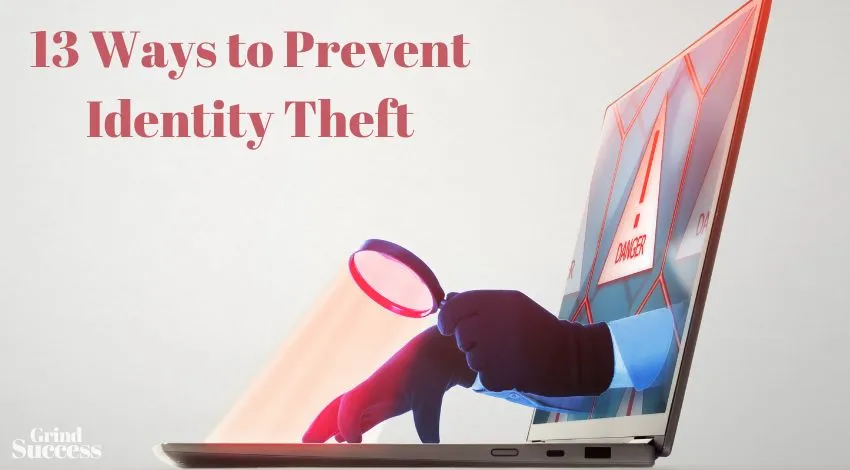13 Ways to Prevent Identity Theft

Identity theft is a serious crime that occurs when someone uses your personal data — your name, Social Security number, birth date, etc. — to impersonate you, typically using that information to steal from you. The Federal Trade Commission received 1.43 million complaints of identity theft from consumers in 2021.
Identity thieves may drain your bank and investment accounts, open new credit lines, get utility service, steal your tax refund, use your insurance information to get medical treatments or give police your name and address when they are arrested.
How to Prevent Identity
1. Freeze your credit
Freezing your credit with all three major credit bureaus — Equifax, Experian, and TransUnion — restricts access to your records so new credit files cannot be opened. It’s free to freeze your credit and unfreeze when you want to open an account, and it provides the best protection against an identity thief using your data to open a new account.
2. Safeguard your Social Security number
Your Social Security number is the master key to your personal data. Guard it as best you can. When you are asked for your number, ask why it is needed and how it will be protected. Don’t carry your card with you. Securely store or shred paperwork containing your Social Security number.
3. Be alert to phishing and spoofing
Scammers can make phone calls appear to come from government entities or businesses, and emails that appear to be legitimate may be attempts to steal your information.
Initiate a callback or return email yourself, working from a known entity such as the official website, rather than responding to a call or email. And be wary of attachments — many contain malware.
4. Use strong passwords and add an authentication step
Use a password manager to create and store complex, unique passwords for your accounts. Don’t reuse passwords. Adding an authenticator app can reduce your risk. Don’t rely on security questions to keep your accounts safe; your mother’s maiden name and your pet’s name aren’t hard to find.
Think carefully about what you post on social media so you don’t give away key data or clues about how you answer security questions.
5. Use alerts
Many financial institutions will text or email you when transactions are made on your accounts. Sign up so that you know when and where your credit cards are used when there are withdrawals or deposits to financial accounts and more.
6. Watch your mailbox
Stolen mail is one of the easiest paths to a stolen identity. Have your mail held if you’re out of town. Consider a U.S. Postal Service-approved lockable mailbox. You can also sign up for Informed Delivery through USPS, which gives you a preview of your mail so you can tell if anything is missing.
7. Use a digital wallet
If you’re paying online or in a store, use a digital wallet, an app containing secure, digital versions of credit and debit cards. You can use it to shop online or at a compatible checkout terminal. Transactions are tokenized and encrypted, which makes them safer. In addition, contactless transactions have fewer health risks.
8. Protect your mobile devices
Mobile devices can be a real risk. According to Javelin’s report, only 48% of us routinely lock our mobile devices. Use passwords on your electronic devices. Use a banking app rather than a mobile browser for banking.
9. Be mysterious on social networks
The more information you share online, the easier it’s going to be for someone to get their hands on it. Be cautious about who you accept as a friend on social networks, never share your birth year publicly, and consider not sharing your hometown or high school name either.
10. Check your credit reports regularly
The three major credit reporting bureaus are giving consumers access to free credit reports weekly through the end of 2023, accessible by using AnnualCreditReport.com. Check to be sure that accounts are being reported properly and watch for signs of fraud, like accounts you don’t recognize.
11. Monitor financial and medical statements
Read financial statements. Make sure you recognize every transaction. Know the due dates and call to investigate if you do not receive an expected bill. Review “explanation of benefits” statements to make sure you recognize the services provided to guard against healthcare fraud.
12. Enable two-factor authentication on devices and accounts
Two-factor authentication adds a second level of authentication to an account log-in. When you have to enter only your username and one password, that’s considered a single-factor authentication. 2FA requires the user to have two out of three types of credentials before being able to access an account.
13. Opt out of prescreened credit card offers
Prescreened credit and insurance offers can provide many benefits. However, many people find that they receive more offers than they’d like. The Federal Trade Commission’s official website provides information on how you can opt out of these offers.
Why should I care if someone steals my identity?
Identity theft can have serious implications for your financial health. It can lead to unauthorized charges on your credit cards, changes to your personal information, and even fraudulent activity on your bank accounts. It can take months, or even years, to fully recover from identity theft.
What can a thief do with my personal information?
With your personal information, a thief can open new credit accounts, make purchases, get a driver’s license, and even file a fraudulent tax return in your name. They can also use your personal information to commit other types of fraud, such as insurance fraud or medical fraud.






